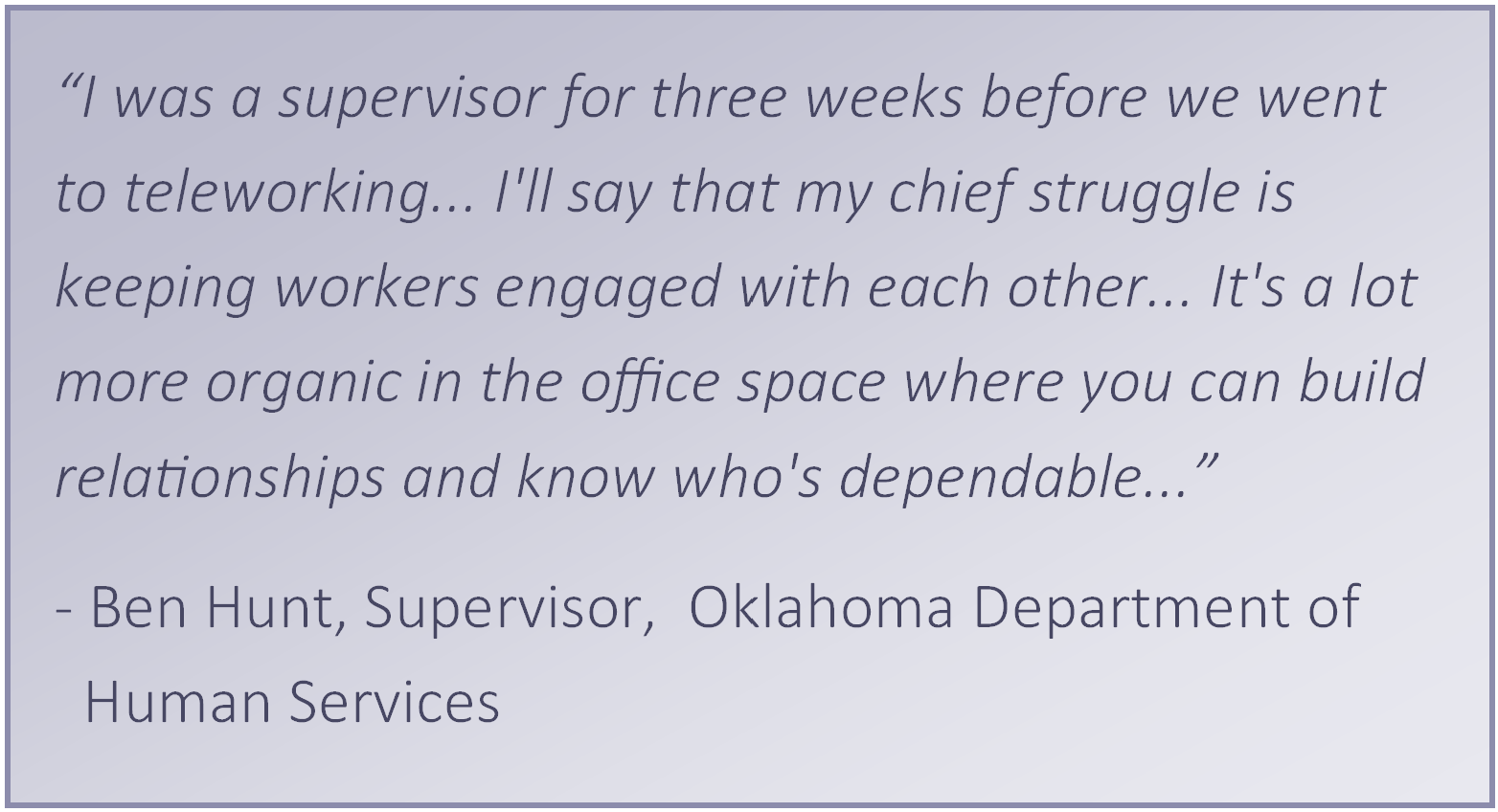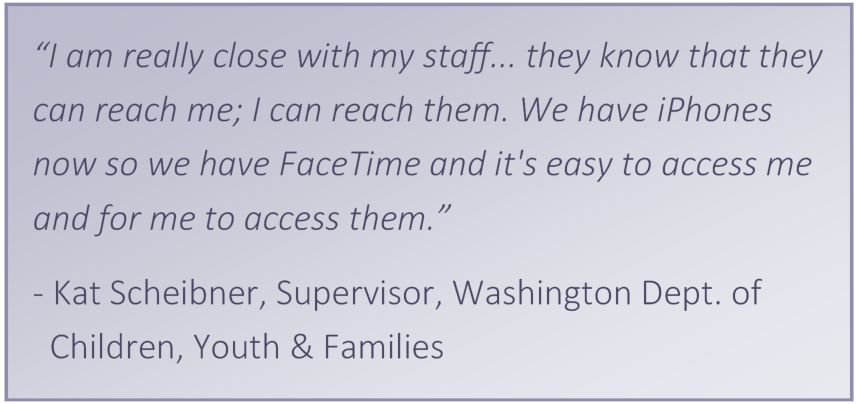Supervision in a Virtual Workplace
Author: Cynthia Parry, PhD
Some agencies have increased their use of telework due to office closures, a desire to decrease their carbon footprint, or because of the pandemic. This can add stress on supervisors as they have to manage staff virtually. Remote supervision requires changes in communication (both styles and tools) which can result in staff feeling micromanaged or neglected. Navigating these and other issues have been difficult for many child welfare agencies.
The QIC-WD sites, like other child welfare agencies around the country, pivoted to virtual supervision quickly due to the pandemic. Most supervisors were unprepared for managing a virtual workforce and are learning by doing. They express a range of concerns, including how to adapt their supervision style to meet the needs of individual staff members, how frequently to communicate with staff and by what means, how to provide opportunities for learning, collaboration, and information sharing, and how best to integrate new staff into their existing teams. In this QIC-Take we share what we are learning from QIC-WD sites and others, as well as links to advice on best practices in remote supervision because some form of remote work (and therefore virtual supervision) is going to be a workforce element for the foreseeable future.
What We’re Seeing
Concerns expressed by supervisors in our sites have varied with their experience and comfort with managing virtually. Many supervisors who were new to managing in a remote setting (a.k.a., telework) were worried about ensuring worker productivity. For some, this led to more frequent communication with workers to assess progress and quality of their work. In one QIC-WD site, 20% of supervisors indicated that they communicated with staff more frequently since moving to virtual work. The percentage who checked in with staff daily increased by more than 13%. How closely the work was monitored also varied with the agency’s comfort with worker productivity. In at least one site, workers throughout the agency were required to provide a detailed accounting of how they spent their time each day because of an agency-wide concern with the quality of the work.
![“I probably talked to everyone daily, just see how they're going ... I did have employee that it [telework] didn't really work for her. She was more of an outgoing person. So just making sure that she's taken the time she need that she supported. If I nee](https://www.qic-wd.org/sites/default/files/supervision%20quote%201.png) As supervisors have become more familiar with the demands of virtual supervision, other concerns have risen to the forefront. Supervisors are recognizing that “one size does not fit all” and that supervision style and frequency should be adapted to meet individual needs. Supervisors in focus groups conducted in one QIC-WD site described a need to be more intentional about reaching out and checking in with people and to tailor supervision to needs of individual staff. Others have described the need to be more flexible and patient. At the 2021 Annual Education Conference of the National Staff Development and Training Association (NSDTA), one participant (in a discussion about leadership in a virtual environment) discussed initially equating productivity with physical presence. She went on to say that over time she had to find other ways that staff could demonstrate productivity in a virtual environment and emphasized the importance of developing trust between staff and supervisors.
As supervisors have become more familiar with the demands of virtual supervision, other concerns have risen to the forefront. Supervisors are recognizing that “one size does not fit all” and that supervision style and frequency should be adapted to meet individual needs. Supervisors in focus groups conducted in one QIC-WD site described a need to be more intentional about reaching out and checking in with people and to tailor supervision to needs of individual staff. Others have described the need to be more flexible and patient. At the 2021 Annual Education Conference of the National Staff Development and Training Association (NSDTA), one participant (in a discussion about leadership in a virtual environment) discussed initially equating productivity with physical presence. She went on to say that over time she had to find other ways that staff could demonstrate productivity in a virtual environment and emphasized the importance of developing trust between staff and supervisors.
 Supervisors have also become increasingly concerned with how to build in the organic opportunities for learning that typically exist in an office setting that are lost while working virtually. One person described this by saying “What has been missing is a creative space to brainstorm with others.” One strategy that supervisors in multiple QIC-WD sites have reported to meet this need is to hold more frequent team meetings to collaborate and share knowledge. In one site, approximately 25% of supervisors reported holding more frequent unit meetings. Another 30% reported more frequent use of brief “team huddles” to plan the work and exchange information on their cases, and 25% reported more frequent use of group supervision. Others have described having more frequent case staffings. Supervisors are also exploring new ways to stay connected to ensure that the quality of the work is maintained, and staff are supported, including texts, video conferences, phone, and e-mail.
Supervisors have also become increasingly concerned with how to build in the organic opportunities for learning that typically exist in an office setting that are lost while working virtually. One person described this by saying “What has been missing is a creative space to brainstorm with others.” One strategy that supervisors in multiple QIC-WD sites have reported to meet this need is to hold more frequent team meetings to collaborate and share knowledge. In one site, approximately 25% of supervisors reported holding more frequent unit meetings. Another 30% reported more frequent use of brief “team huddles” to plan the work and exchange information on their cases, and 25% reported more frequent use of group supervision. Others have described having more frequent case staffings. Supervisors are also exploring new ways to stay connected to ensure that the quality of the work is maintained, and staff are supported, including texts, video conferences, phone, and e-mail.
 Many public child welfare agency leaders are also expressing a related concern about how best to onboard and integrate new staff. This is a particular challenge in jurisdictions that have streamlined and condensed the onboarding process to a virtual one. Leaders at the NSDTA conference reported more frequent use of team building exercises, as well as changes to onboarding processes designed to provide additional support to new hires. They described setting aside time in virtual meetings for conversations about non-work activities or weekend plans and sending out invitations for virtual “water coolers” to help staff get to know each other. They also reported onboarding groups of new hires to foster connections, and strategies such as assigning a liaison to welcome each group and assigning peer mentors. One conference participant emphasized agency efforts to gather feedback to improve the onboarding process itself. In that jurisdiction managers meet individually with new hires to gather feedback regarding their onboarding experience and have made changes to improve the process.
Many public child welfare agency leaders are also expressing a related concern about how best to onboard and integrate new staff. This is a particular challenge in jurisdictions that have streamlined and condensed the onboarding process to a virtual one. Leaders at the NSDTA conference reported more frequent use of team building exercises, as well as changes to onboarding processes designed to provide additional support to new hires. They described setting aside time in virtual meetings for conversations about non-work activities or weekend plans and sending out invitations for virtual “water coolers” to help staff get to know each other. They also reported onboarding groups of new hires to foster connections, and strategies such as assigning a liaison to welcome each group and assigning peer mentors. One conference participant emphasized agency efforts to gather feedback to improve the onboarding process itself. In that jurisdiction managers meet individually with new hires to gather feedback regarding their onboarding experience and have made changes to improve the process.
 As changes in working arrangements in response to the pandemic have continued, there has been increasing recognition of the need to support staff who are stressed and may be struggling with feeling isolated, overwhelmed with juggling work and personal demands or fearful of returning to the office and face-to-face work with clients. Supervisors have recognized the importance of creating a psychologically safe space for staff to share how they are coping and a sense that “we are all in this together.” One supervisor described how being transparent about her own stress with her team encouraged them to open up about their struggles and allowed her to better support them, which in turn lowered her stress and made her feel more confident about her supervision. Supervisors have reported using a variety of specific strategies to help staff manage stress, including self-care tips via e-mail, stretch breaks during meetings, and virtual “walks” with co-workers. They have also emphasized the need to maintain work-life balance, recognizing that boundaries have become blurred, and that in some cases, workloads have increased as jurisdictions struggle with high rates of turnover. Many are encouraging staff to set boundaries and to recognize that this is necessary and expected.
As changes in working arrangements in response to the pandemic have continued, there has been increasing recognition of the need to support staff who are stressed and may be struggling with feeling isolated, overwhelmed with juggling work and personal demands or fearful of returning to the office and face-to-face work with clients. Supervisors have recognized the importance of creating a psychologically safe space for staff to share how they are coping and a sense that “we are all in this together.” One supervisor described how being transparent about her own stress with her team encouraged them to open up about their struggles and allowed her to better support them, which in turn lowered her stress and made her feel more confident about her supervision. Supervisors have reported using a variety of specific strategies to help staff manage stress, including self-care tips via e-mail, stretch breaks during meetings, and virtual “walks” with co-workers. They have also emphasized the need to maintain work-life balance, recognizing that boundaries have become blurred, and that in some cases, workloads have increased as jurisdictions struggle with high rates of turnover. Many are encouraging staff to set boundaries and to recognize that this is necessary and expected.
Looking Ahead
 The QIC-WD sites’ future plans range from bringing everyone back into the office when it can be done safely to making virtual work permanent, adopting a hoteling model or formal telework policy. For at least the near future, most supervisors will need to continue to grapple with how best to support, monitor, and integrate staff working virtual or hybrid schedules. Moreover, some sites are experiencing high levels of turnover and difficulty filling vacant positions. This is adding to the stress experienced by staff as they try to meet the needs of children and families, and supervisors as they try to ensure that the work gets done. There will be a continued need to support supervisors to develop new skills and strategies for managing the work and the needs of their staff. There are a number of resources available related to virtual supervision in child welfare, some of which are listed below. We also want to highlight some promising practices based on what we have heard from frontline supervisors.
The QIC-WD sites’ future plans range from bringing everyone back into the office when it can be done safely to making virtual work permanent, adopting a hoteling model or formal telework policy. For at least the near future, most supervisors will need to continue to grapple with how best to support, monitor, and integrate staff working virtual or hybrid schedules. Moreover, some sites are experiencing high levels of turnover and difficulty filling vacant positions. This is adding to the stress experienced by staff as they try to meet the needs of children and families, and supervisors as they try to ensure that the work gets done. There will be a continued need to support supervisors to develop new skills and strategies for managing the work and the needs of their staff. There are a number of resources available related to virtual supervision in child welfare, some of which are listed below. We also want to highlight some promising practices based on what we have heard from frontline supervisors.
- Take time to understand the demands of virtual work and be prepared to be adapt your supervision practices. Working virtually presents different challenges than working in an office, including isolation, communication breakdowns and bottlenecks, distractions, and a lack of organic opportunities for collaboration and skill development. These will require an array of strategies to engage, develop, and monitor staff working virtually. Seek staff feedback. Don’t assume you know what staff needs.
- Set and communicate clear productivity standards and develop plans for monitoring and checking in with staff. Recognize that one size doesn’t fit all. Some staff may need more structure than others. Guard against equating productivity with physical presence.
- Pay special attention to onboarding new employees. Consider ways to build community such as onboarding cohorts. Check in with new staff frequently and spend more time on activities to acclimate new employees to agency values and culture. Consider designating a peer mentor for an individual or a liaison for each new hire cohort. Collaborate with Human Resources on ways to streamline paperwork for new hires.
 Make sure everyone has access to the tools they need and that they know how to use them. These tools may be technological resources but also such things as manuals, supplies, or credit cards for job-related purchasing.
Make sure everyone has access to the tools they need and that they know how to use them. These tools may be technological resources but also such things as manuals, supplies, or credit cards for job-related purchasing. - Set aside time for the team to interact with you and with each other for sharing information, planning work, and developing new skills. Some options are one-on-one conferences, group supervision, brief check-ins, or work planning “huddles.”
- Attend to the emotional well-being of staff. Check in with each staff member one-on-one to see how they are doing and offer emotional support. Consider providing resources to the whole team such as self-care desk aides, self-care tips, or links to on-line wellness classes.
- Understand that leaders need self-care too. The stresses of a quick pivot to virtual work affect you as well as your staff. Extend the same kindness to yourself that you would to a staff member who is struggling. Seek out sources of professional and personal support and practice self-care.
Additional resources on virtual supervision
- Accountability in a Virtual Work Environment, Quality Improvement Center for Workforce Development
- Supervising Child Welfare Professionals Virtually during a Pandemic, Quality Improvement Center for Workforce Development
- Virtually Supervising Child Welfare Professionals During a Pandemic, National Child Welfare Workforce Institute